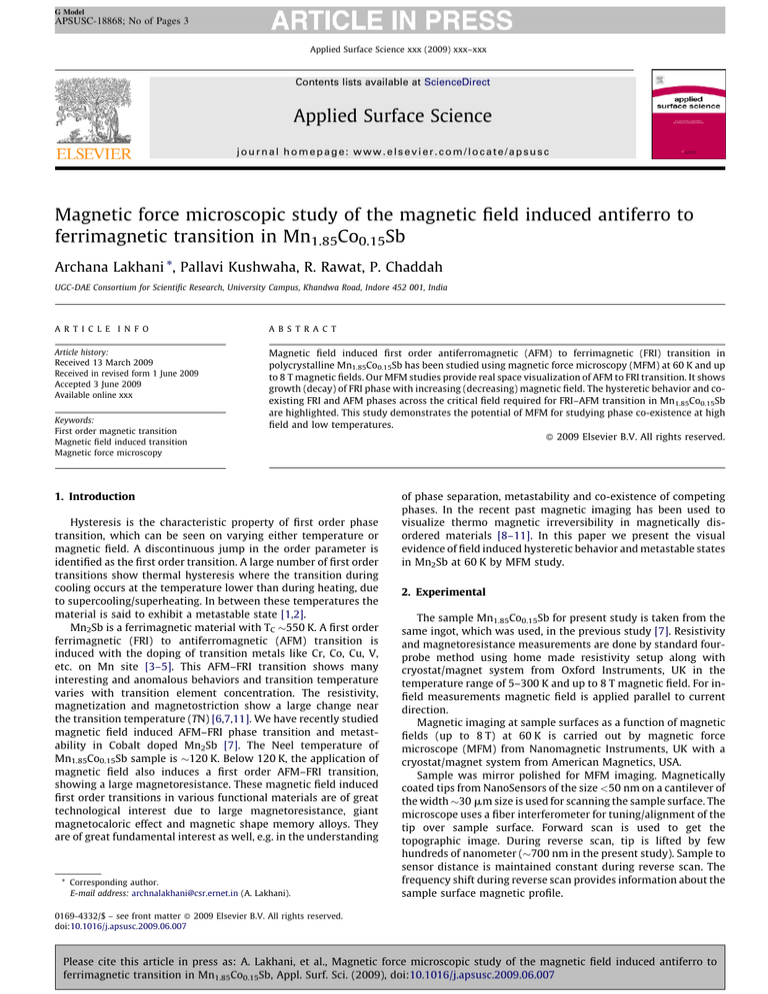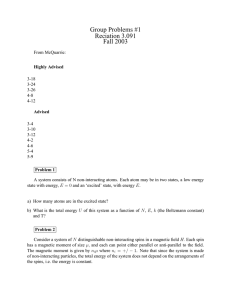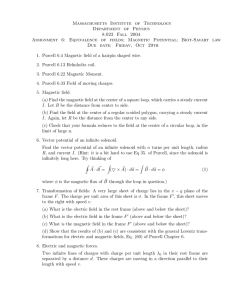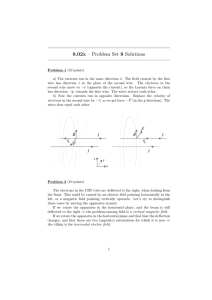
G Model
APSUSC-18868; No of Pages 3
Applied Surface Science xxx (2009) xxx–xxx
Contents lists available at ScienceDirect
Applied Surface Science
journal homepage: www.elsevier.com/locate/apsusc
Magnetic force microscopic study of the magnetic field induced antiferro to
ferrimagnetic transition in Mn1.85Co0.15Sb
Archana Lakhani *, Pallavi Kushwaha, R. Rawat, P. Chaddah
UGC-DAE Consortium for Scientific Research, University Campus, Khandwa Road, Indore 452 001, India
A R T I C L E I N F O
A B S T R A C T
Article history:
Received 13 March 2009
Received in revised form 1 June 2009
Accepted 3 June 2009
Available online xxx
Magnetic field induced first order antiferromagnetic (AFM) to ferrimagnetic (FRI) transition in
polycrystalline Mn1.85Co0.15Sb has been studied using magnetic force microscopy (MFM) at 60 K and up
to 8 T magnetic fields. Our MFM studies provide real space visualization of AFM to FRI transition. It shows
growth (decay) of FRI phase with increasing (decreasing) magnetic field. The hysteretic behavior and coexisting FRI and AFM phases across the critical field required for FRI–AFM transition in Mn1.85Co0.15Sb
are highlighted. This study demonstrates the potential of MFM for studying phase co-existence at high
field and low temperatures.
ß 2009 Elsevier B.V. All rights reserved.
Keywords:
First order magnetic transition
Magnetic field induced transition
Magnetic force microscopy
1. Introduction
Hysteresis is the characteristic property of first order phase
transition, which can be seen on varying either temperature or
magnetic field. A discontinuous jump in the order parameter is
identified as the first order transition. A large number of first order
transitions show thermal hysteresis where the transition during
cooling occurs at the temperature lower than during heating, due
to supercooling/superheating. In between these temperatures the
material is said to exhibit a metastable state [1,2].
Mn2Sb is a ferrimagnetic material with TC 550 K. A first order
ferrimagnetic (FRI) to antiferromagnetic (AFM) transition is
induced with the doping of transition metals like Cr, Co, Cu, V,
etc. on Mn site [3–5]. This AFM–FRI transition shows many
interesting and anomalous behaviors and transition temperature
varies with transition element concentration. The resistivity,
magnetization and magnetostriction show a large change near
the transition temperature (TN) [6,7,11]. We have recently studied
magnetic field induced AFM–FRI phase transition and metastability in Cobalt doped Mn2Sb [7]. The Neel temperature of
Mn1.85Co0.15Sb sample is 120 K. Below 120 K, the application of
magnetic field also induces a first order AFM–FRI transition,
showing a large magnetoresistance. These magnetic field induced
first order transitions in various functional materials are of great
technological interest due to large magnetoresistance, giant
magnetocaloric effect and magnetic shape memory alloys. They
are of great fundamental interest as well, e.g. in the understanding
* Corresponding author.
E-mail address: archnalakhani@csr.ernet.in (A. Lakhani).
of phase separation, metastability and co-existence of competing
phases. In the recent past magnetic imaging has been used to
visualize thermo magnetic irreversibility in magnetically disordered materials [8–11]. In this paper we present the visual
evidence of field induced hysteretic behavior and metastable states
in Mn2Sb at 60 K by MFM study.
2. Experimental
The sample Mn1.85Co0.15Sb for present study is taken from the
same ingot, which was used, in the previous study [7]. Resistivity
and magnetoresistance measurements are done by standard fourprobe method using home made resistivity setup along with
cryostat/magnet system from Oxford Instruments, UK in the
temperature range of 5–300 K and up to 8 T magnetic field. For infield measurements magnetic field is applied parallel to current
direction.
Magnetic imaging at sample surfaces as a function of magnetic
fields (up to 8 T) at 60 K is carried out by magnetic force
microscope (MFM) from Nanomagnetic Instruments, UK with a
cryostat/magnet system from American Magnetics, USA.
Sample was mirror polished for MFM imaging. Magnetically
coated tips from NanoSensors of the size <50 nm on a cantilever of
the width 30 mm size is used for scanning the sample surface. The
microscope uses a fiber interferometer for tuning/alignment of the
tip over sample surface. Forward scan is used to get the
topographic image. During reverse scan, tip is lifted by few
hundreds of nanometer (700 nm in the present study). Sample to
sensor distance is maintained constant during reverse scan. The
frequency shift during reverse scan provides information about the
sample surface magnetic profile.
0169-4332/$ – see front matter ß 2009 Elsevier B.V. All rights reserved.
doi:10.1016/j.apsusc.2009.06.007
Please cite this article in press as: A. Lakhani, et al., Magnetic force microscopic study of the magnetic field induced antiferro to
ferrimagnetic transition in Mn1.85Co0.15Sb, Appl. Surf. Sci. (2009), doi:10.1016/j.apsusc.2009.06.007
G Model
APSUSC-18868; No of Pages 3
A. Lakhani et al. / Applied Surface Science xxx (2009) xxx–xxx
2
Fig. 1. Resistivity vs temperature for Mn1.85Co0.15Sb in zero field during cooling and
heating cycles.
3. Results and discussions
Fig. 1 shows the temperature dependence of zero field
resistivity with decreasing and increasing temperature. Antiferro
to ferrimagnetic transition is seen as sharp drop in resistivity with
increasing temperature which starts around 90 K. Transition
temperature, which is taken as the inflection point of the resistivity
is found to be 120 K. During cooling reverse transformation
occurs at lower temperature compared to warming cycle resulting
in a hysteresis of 10 K around transition region. Besides
hysteresis transition is broad with the width of 50 K. Such a
broadening of transition region is a result of disorder inherent in
substitutional alloys. This broadening of transition region gives rise
to co-existing AFM and FRI phases, the field dependence of which
has been studied recently by us, using Scanning Hall Microscopy
[11]. In this study it has been shown that state of the system
depends on the path followed to reach the measurement
temperature. Earlier we have demonstrated by macroscopic
measurements that difference in initial state persists only within
the supercooling and superheating spinodal and vanish beyond it.
This is shown in Fig. 2, by r–H measurement at 60 K, where zero
field resistivity is same before and after the application of magnetic
field. Therefore, we obtain completely homogeneous state after
complete cycle of magnetic field at this temperature (below 120 K).
MFM images at various constant magnetic fields are shown in
Fig. 2. Measurement protocol was identical to that used in R–H
measurement. Each MFM image labeled by alphabets (A–O)
corresponds to the points on R–H curve represented by the stars.
All the images while decreasing and increasing magnetic field are
plotted on the same scale. Image A and B in the presence of 1 and
2 T magnetic field shows almost homogeneous AFM state
represented by light color. With further increase in magnetic field
system tends to become FRI (represented by dark color) and starts
getting inhomogeneous as seen in image C taken at 3 T, where both
AFM and FRI phases co-exist. On increasing the field while going
from A to H system tends to become ferrimagnetic and turn
completely ferrimagnetic at 8 T. In between fields at 4, 5 and 6 T
both FRI and AFM phases co-exist with increase in FRI phase,
respectively. Similarly while decreasing field from 8 to 0 T system
tends to AFM state with more FRI phase fraction in comparison to
Fig. 2. (A–O) Magnetic force microcopy images (17.8 mm 17.8 mm) of Mn1.85Co0.15Sb in presence of various constant magnetic fields with increasing and decreasing field.
Each point indicated by alphabets (A–O) in r–H at 60 K reached by warming represents the corresponding MFM image.
Please cite this article in press as: A. Lakhani, et al., Magnetic force microscopic study of the magnetic field induced antiferro to
ferrimagnetic transition in Mn1.85Co0.15Sb, Appl. Surf. Sci. (2009), doi:10.1016/j.apsusc.2009.06.007
G Model
APSUSC-18868; No of Pages 3
A. Lakhani et al. / Applied Surface Science xxx (2009) xxx–xxx
3
Fig. 3. Topographic (left) and magnetic (right) images at (i) 4 T, (ii) 5 T and (iii) 8 T. Top and bottom images in figure (i) and (ii) are the images taken with increasing and
decreasing field cycles, respectively.
increasing field cycle at all corresponding field values. This
difference between the two field cycles in MFM images provides
the mesoscopic origin of hysteretic behavior in r–H curve.
Some of the representative MFM images along with corresponding topography across the magnetic field induced AFM–FRI
transition are shown in Fig. 3. Fig. 3(i) taken during field increasing
cycle at 4 T shows almost AFM state with few dark regions showing
the growth of FRI phase. While during field decreasing cycle it
shows co-existing FRI (dark region) and AFM (light region). The fact
that the dark regions are not a result of topography is evident from
the comparison of topographic and magnetic images. The regions
studied during field increasing and decreasing cycle seems to be
different from topographic images. However, magnetic images
clearly show higher FRI phase fraction during field reducing cycle.
Similar inference can be drawn from 5 T images shown in Fig. 3(ii).
These results provide origin of hysteretic behavior in magnetoresistance. At 8 T almost entire sample is homogeneous FRI. Small
bright features observed in MFM images seem to be correlated
with topography as shown in Fig. 3(iii).
4. Conclusions
Magnetic force microscopy (MFM) has been used to study the
field induced AFM to FRI transition in Mn1.85Co0.15Sb. These
images show nucleation and growth of FRI phase with increasing
magnetic field on mesoscopic length scales. It provides the
mesoscopic origin of hysteretic magnetic field induced transition
in magnetoresistance studies. Different phase fractions are
confirmed during decreasing and increasing field cycles consistent with our magnetoresistance studies. This study shows the
potential of MFM in studying field induced magnetic transitions
and phase co-existence at high magnetic field and low temperature.
References
[1] P. Chaddah, Pramana J. Phys. 67 (2006) 113.
[2] P. Chaddah, S.B. Roy, Pramana J. Phys. 54 (2000) 857.
[3] T.J. Swoboda, W.H. Cloud, T.A. Bither, M.S. Sadler, H.S. Jarret, Phys Rev. Lett. 4
(1960) 509.
[4] T. Kanomata, H. Ido, J. Appl. Phys. 55 (1984) 2039.
[5] M.K. Wilkinson, N.S. Gingrisch, C.G. Shull, J. Phys. Chem. Solids 2 (1957) 289.
[6] M.I. Baraschevich, T. Goto, N.V. Baranov, V.S. Gaviko, Physica B 71 (2004) 351.
[7] P. Kushwaha, R. Rawat, P. Chaddah, J. Phys. Condens. Matter 20 (2008) 22204.
[8] C. Israel, W. Wu, A. de Lozanne, Appl. Phys. Lett. 86 (2006) 32502.
[9] W. Wu, C. Israel, N. Hur, S. Park, S.W. Cheong, A. Loanne, Nat. Mater. 5 (2006)
881.
[10] C. Israel, L. Granja, T.M. Chuang, L.E. Hueso, D. Sanchez, J.L. Prieto, P. Levy, A. De
Lojanne, N.D. Mathur, Phys Rev. B 78 (2008) 54409.
[11] P. Kushwaha, A. Lakhani, R. Rawat, P. Chaddah, Phys. Rev. B 79 (2009) 13240.
Please cite this article in press as: A. Lakhani, et al., Magnetic force microscopic study of the magnetic field induced antiferro to
ferrimagnetic transition in Mn1.85Co0.15Sb, Appl. Surf. Sci. (2009), doi:10.1016/j.apsusc.2009.06.007







